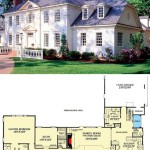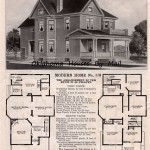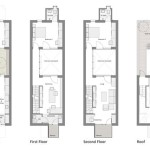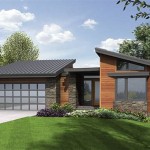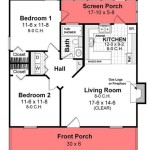Small one bedroom house floor plans refer to architectural designs for compact residential units featuring a single bedroom and a limited footprint. These plans prioritize space efficiency and functionality, making them suitable for individuals, couples, or small families seeking affordable and low-maintenance living arrangements. An example of a real-world application is a cozy cottage with an open-plan living area, a compact kitchen, and a single bedroom with ample closet space.
In this article, we will explore various small one bedroom house floor plans, their advantages, and considerations for creating functional and aesthetically pleasing living spaces. We will provide insights into efficient space planning, natural light optimization, and incorporating smart storage solutions to maximize comfort and convenience in compact homes.
When designing small one bedroom house floor plans, consider these key points:
- Maximize natural light
- Emphasize open floor plans
- Incorporate smart storage
- Prioritize multi-purpose spaces
- Utilize vertical space
- Choose space-saving furniture
- Consider outdoor living areas
- Incorporate energy-efficient features
By implementing these principles, you can create functional, comfortable, and visually appealing small one bedroom homes.
Maximize natural light
Incorporating ample natural light into small one bedroom house floor plans is crucial for creating a bright and inviting living space. Natural light not only enhances the overall ambiance of a home but also provides numerous benefits, including reducing energy consumption, improving mood, and promoting well-being.
- Place windows strategically: Position windows on multiple walls to allow light to penetrate from different angles. Consider larger windows or skylights to maximize light intake.
- Use reflective surfaces: Incorporate mirrors, light-colored walls, and glossy finishes to reflect and amplify natural light throughout the space.
- Avoid obstructions: Ensure that furniture, curtains, or other objects do not block the flow of natural light. Opt for sheer curtains or blinds that allow light to filter through.
- Consider the orientation of the house: Plan the placement of windows and rooms according to the sun’s path. South-facing windows receive the most sunlight, making them ideal for living areas and bedrooms.
By maximizing natural light in small one bedroom house floor plans, you can create a more spacious, inviting, and energy-efficient living environment.
Emphasize open floor plans
Open floor plans are a key element in creating the illusion of spaciousness in small one bedroom house floor plans. By minimizing walls and partitions, you can maximize the flow of natural light and create a more cohesive living space.
- Remove unnecessary walls: Consider knocking down walls between the living room, dining area, and kitchen to create a more open and airy feel. This allows for better sightlines and easier movement throughout the space.
- Use room dividers: Instead of solid walls, incorporate room dividers such as screens, bookshelves, or curtains to separate different functional areas while maintaining an open feel.
- Maximize vertical space: Utilize high ceilings by incorporating lofts or mezzanines to create additional living space without increasing the footprint of the home.
- Choose furniture wisely: Opt for furniture pieces that are low-profile and do not obstruct sightlines. Consider multifunctional furniture that can serve multiple purposes, such as a sofa bed or a coffee table with built-in storage.
By emphasizing open floor plans in small one bedroom house floor plans, you can create a more spacious, inviting, and functional living environment.
Incorporate smart storage
In small one bedroom house floor plans, smart storage solutions are essential for maximizing space utilization and maintaining a clutter-free living environment.
- Utilize vertical space: Install shelves, cabinets, and drawers that extend vertically to make the most of wall space. Consider floor-to-ceiling storage units to maximize storage capacity.
- Choose multifunctional furniture: Opt for furniture pieces that serve multiple purposes, such as ottomans with built-in storage, beds with drawers, or coffee tables with hidden compartments.
- Incorporate built-in storage: Designate specific areas for storage, such as built-in closets, pantries, and bookshelves. This helps to create a more streamlined and organized living space.
- Maximize underutilized spaces: Utilize the space under beds, stairs, and sloped ceilings for storage. Install drawers, shelves, or baskets to store items that are not frequently used.
By incorporating smart storage solutions into small one bedroom house floor plans, you can create a more functional and organized living space that maximizes space utilization and minimizes clutter.
Prioritize multi-purpose spaces
In small one bedroom house floor plans, prioritizing multi-purpose spaces is crucial for maximizing functionality and creating a comfortable living environment. By designing spaces that can serve multiple purposes, you can save space and create a more versatile and adaptable home.
One effective way to incorporate multi-purpose spaces is to create a combined living and dining area. This open-plan layout allows for seamless transitions between activities and creates a more spacious feel. To further enhance functionality, consider incorporating built-in seating or storage solutions into the design, such as a window seat with drawers or a coffee table with hidden compartments.
Another smart space-saving technique is to utilize the bedroom as a multi-purpose room. By incorporating a desk or workspace into the bedroom design, you can create a dedicated area for work or study without sacrificing a separate room. Additionally, consider installing a Murphy bed or wall bed that can be folded away when not in use, freeing up floor space during the day.
Multi-purpose spaces can also extend to outdoor areas. By designing a small patio or balcony that can serve as both a relaxation spot and an outdoor dining area, you can maximize the functionality of your outdoor space. Consider incorporating built-in seating or planters to further enhance the usability and aesthetic appeal of your outdoor living area.
Utilize vertical space
In small one bedroom house floor plans, maximizing vertical space is key to creating a more spacious and functional living environment. By utilizing the height of your home, you can create additional storage and living areas without increasing the footprint of the home.
- Install shelves and cabinets that extend vertically: Make use of wall space by installing shelves and cabinets that reach from floor to ceiling. This provides ample storage for books, dcor, and other belongings, while minimizing the use of floor space.
- Create a loft or mezzanine: If your home has high ceilings, consider adding a loft or mezzanine to create an additional living space, such as a sleeping area, home office, or guest room. This is a great way to add extra square footage without expanding the home’s footprint.
- Use stackable furniture: Choose furniture pieces that can be stacked or nested, such as stackable chairs, nesting tables, and ottomans that can be used as extra seating or footrests when needed.
- Hang curtains from the ceiling: Instead of using traditional curtain rods, hang curtains from the ceiling to create the illusion of higher ceilings and make the room feel more spacious.
By utilizing vertical space effectively, you can create a more functional and visually appealing small one bedroom house floor plan.
Choose space-saving furniture
When selecting furniture for small one bedroom house floor plans, it is crucial to prioritize space-saving designs that maximize functionality without compromising comfort and style.
Opt for multifunctional furniture: Choose furniture pieces that can serve multiple purposes, such as ottomans with built-in storage, beds with drawers, or coffee tables with hidden compartments. This allows you to save space while keeping your belongings organized and easily accessible.
Consider vertical storage: Utilize vertical space by choosing furniture with built-in shelves or drawers that extend vertically. This is especially useful for storing books, DVDs, and other items that can take up valuable floor space.
Choose furniture with a small footprint: Select furniture pieces that are appropriately sized for the space available. Avoid bulky or oversized items that can make the room feel cramped and cluttered. Instead, opt for furniture with a smaller footprint, such as a love seat instead of a sofa, or a small dining table with chairs that can be tucked under the table when not in use.
Use stackable and foldable furniture: Incorporate stackable or foldable furniture into your design to save space when not in use. Stackable chairs can be easily stored in a closet or corner when not needed, while foldable tables can be set up and taken down as required.
By carefully selecting space-saving furniture, you can create a functional and comfortable living space in your small one bedroom house floor plan.
Consider outdoor living areas
Incorporating outdoor living areas into small one bedroom house floor plans can greatly enhance the functionality and enjoyment of your home. By extending your living space outdoors, you can create a seamless connection between the interior and exterior of your home, making it feel more spacious and inviting.
- Create a private oasis: Designate a small outdoor area as a private sanctuary where you can relax and unwind. Add comfortable seating, lush plants, and ambient lighting to create a cozy and inviting atmosphere.
- Maximize space with vertical gardening: Utilize vertical space by installing hanging planters or trellises for climbing plants. This is a great way to add greenery and privacy to your outdoor area without taking up valuable floor space.
- Incorporate a small deck or patio: Even small one bedroom house floor plans can accommodate a compact deck or patio. This provides an outdoor space for dining, entertaining, or simply enjoying the fresh air.
- Utilize a balcony or rooftop terrace: If your home has a balcony or rooftop terrace, make the most of it by creating an outdoor living area. Add comfortable seating, weather-resistant furniture, and potted plants to transform it into an extension of your indoor living space.
By considering outdoor living areas in your small one bedroom house floor plan, you can create a more functional, enjoyable, and visually appealing home that seamlessly blends indoor and outdoor living.
Incorporate energy-efficient features
Incorporating energy-efficient features into small one bedroom house floor plans is essential for creating a sustainable and cost-effective living environment. By implementing these features, you can reduce your energy consumption, lower your utility bills, and contribute to a greener future.
Maximize natural light
Natural light is a renewable and sustainable energy source that can significantly reduce your reliance on artificial lighting. In small one bedroom house floor plans, maximize natural light by incorporating large windows, skylights, and solar tubes. Place windows strategically to allow sunlight to penetrate deep into the home, reducing the need for electric lighting during the day.
Utilize energy-efficient appliances and systems
Choose energy-efficient appliances and systems, such as LED lighting, Energy Star-rated refrigerators, and high-efficiency heating and cooling systems. These appliances and systems consume less energy, resulting in lower utility bills and a reduced carbon footprint. Consider investing in renewable energy sources, such as solar panels or geothermal heating, to further reduce your energy consumption and environmental impact.
Insulate and seal your home
Proper insulation and sealing prevent heat loss in the winter and heat gain in the summer, reducing the demand on your heating and cooling systems. Insulate your walls, attic, and foundation to minimize heat transfer. Seal air leaks around windows, doors, and other openings to prevent drafts and improve energy efficiency.
Use passive design strategies
Passive design strategies, such as proper building orientation, shading devices, and thermal mass, can significantly reduce energy consumption. Orient your home to take advantage of natural sunlight and prevailing breezes. Install awnings, overhangs, or blinds to shade windows from direct sunlight during hot summer months. Incorporate thermal mass, such as concrete or brick, into your home’s design to absorb and release heat, reducing the need for heating and cooling.
By incorporating these energy-efficient features into your small one bedroom house floor plan, you can create a more sustainable, comfortable, and cost-effective living environment.










Related Posts


